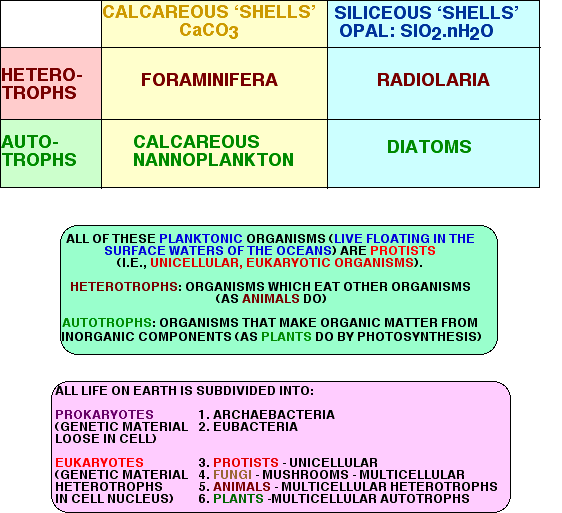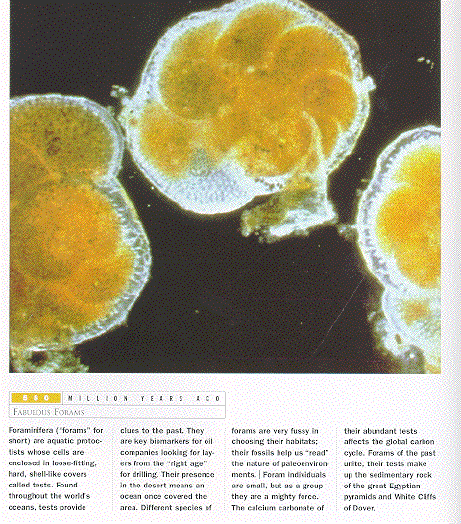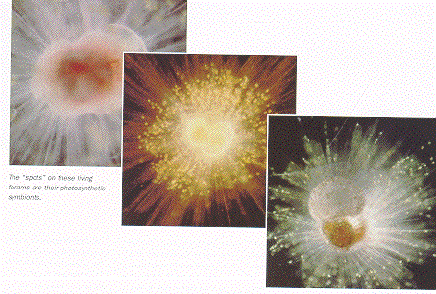
Planktonic foraminifera are unicellular organisms with a complex cell (Eukaryotes), and genetic material within a cell nucleus. Such organisms are classified in the Superkingdom of Protists or Protista. Other eukaryotic superkingdoms include animals, plants, and fungi (mushrooms). Prokaryotic organisms include various types of bacteria, and are subdivided into the two large groups Bacteria and Archaea (both of which have been called 'bacteria' in the past). If you are interested in the subdividion of life on Earth, visit the website of the University of California in Berkeley.
The planktonic foraminifera are only one of the 4 common groups of eukaryotic planktonic organisms in the ocean, which make up the oozes forming on the oceans' floors.

Planktonic foraminifera live floating in the surface waters of the open ocean, and secrete a calcium-carbonate shell. They are thus part of the 'zillions of little organisms' shown in the figure in the handout on sediment cycling and climate. These shells fall to the sea floor after the organisms reproduce. Planktonic foraminifera live in the oceans in species assemblages which reflect the temperature of the ocean waters. Note that high latitude species assemblages have fewer numbers of species, and the few species are all small, round balls (we call them potatoes). At lower latitudes there are many more species, similar to species richness gradients on land (see diversity hand out). These species show much more variability in shape, with flat species surrounded by a heavy rim (called keel; see specimen in figure 1), glassy looking round balls (figure 2), and many varieties of pitted, potato shapes (figures 3 and 4).

Planktonic foraminifera from the recent oceans, arranged by latitudinal species assemblage. Plate from J. P. Kennett, 1982, Marine Geology (Prentice-Hall), Figure 16-1.
In class you received a copy of a world map showing where these various groups of foraminifera occur in the present world oceans.
Planktonic foraminifera in the Recent oceans can be divided in two groups: one groups bears very long, thin calcite spines, the other does not. In the plate above the forms with spines (which break off after the specimens reproduces) have the corrugated-type surface. Many of the spinose foraminifera have symbiotic algae living within their protoplasm. During the day time, they let these algae outside the shell, so that they algae will photosynthesize, and the foraminifera can take up their waste products. At night they haul them in again. All foraminifera, including the ones with symbionts, also eat, pretty much all creatures smaller than they themselves. Some foraminifera appear to prefer algae, other microscopic animals. Foraminifera have sticky pseudopods (long, thin streamers of protoplasm), with which they grab food and place it in contact with their protoplasm, which engulfs their prey and digests it.

This picture shows living, non-spinose planktonic foraminifers. Source: 'A Walk Through Time: from stardust to us', by S. Liebes, E. Sahtouris, and B. Swimme, 1998, John Wiley and Sons.

This picture shows living, spinose planktonic foraminifers. with the duts being symbiotic algae. Source: 'A Walk Through Time: from stardust to us', by S. Liebes, E. Sahtouris, and B. Swimme, 1998, John Wiley and Sons.
We do not know very much about the lives of foraminifera because they live in open ocean and it is difficult to study them there. Many migrate during their life over depth ranges between 50 to 100 m and many hundreds of meters (depending on the species), which may be why there are difficult to keep in laboratories. The juvenile foraminifer show up in surface waters, grow, and when the time for reproduction is there they swarm, and many individuals let gametes free in the ocean water. Gametes is the word for undifferentiated sex cells: foraminifera do not have different-size male (sperm) and female (egg) cells, and there are thus no different sexes. In several species the spawning occurs at full moon; we do not know how the foraminifera know the moon is full.
Planktonic foraminifera originated from benthic foraminifera in the late Jurassic to earliest Cretaceous (that's in the Mesozoic, about 100 million years ago). The first planktonic foraminifera were small, rounded forms ('popcorn'), without ridges, probably with spines. During the Cretaceous, many new species evolved, in many different shapes, with ridges and trangular shapes and so on. Almost all of them became extinct at the end of the Cretaceous, at the time of extinction of the dinosaurs, and only the small, round forms survived. In the early Cenozoic planktonic foraminifera evolved into many new, elaborately shaped forms again. Many of these forms becamse extinct in the later part of the Eocene, between 38 and 33 million years ago, when the Earth went through a period of severe cooling and the ice sheets on Antarctica became established. Once again, the rounded form survived, and for about 10 million years were the dominant forms. Then, in the early Miocene (about 22-23 million years ago), the planktonic foraminifera once again evolved and diversified into many different shapes. Descendants of the Miocene species now populate all the world's oceans. Foraminifera are not very abundant and diverse at high latitudes, and only one species occurs at the highest latitudes, in the Arctic Ocean and around the Antarctic continent.